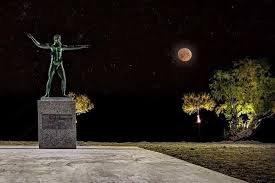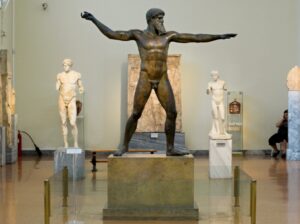Description
We are talking about Poseidon (or Zeus) of Artemisius, a masterpiece of ancient Greek art. Its original is housed in the National Archaeological Museum and its copy, adorns the village of Pefki in North Evia.
It is believed to represent Zeus wielding a myrrh or thunderbolt or Poseidon holding a trident. The object he was holding was not found.
It was found in the sea outside Artemisius in Evia, where a ship had been wrecked in the middle of the 2nd century BC. It was preceded by the finding of the left hand in 1926 and the rest of the statue in 1928. The find was published by George Economos in 1928 in the Proceedings of the Academy of Athens.
The exploration of the shipwreck was stopped in 1928 due to the death of one of the divers and has not been resumed since then. It is believed that the ship was carrying Greek works for export bound for Italy.
It is one of the most beautiful, but also one of the few original bronze statues of the classical period. It is a cast work, of supernatural size and depicts Jupiter or Poseidon. The god is represented standing, naked, in a wide stride. Despite the strictness of the form, the movement is intense and the rendering of the anatomical details particularly successful.
The god's beard is luxuriant and his long hair is gathered in braids around the head, falling in elegant tufts around the forehead.
His eyes, which do not survive, were inset from another material. His left arm is stretched out in front, while the raised right hand would hold the thunderbolt or trident.
In the first case he is identified with Zeus, which is also the most likely, while in the second with Poseidon. It is an excellent example of the strict rhythm of ancient Greek sculpture, and is attributed to a very capable creator, perhaps the famous sculptor Kalami.
Location
-
2656+G6 Πευκί, Greece



Add a review